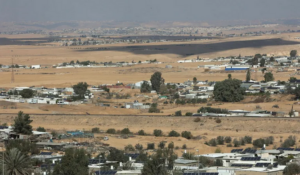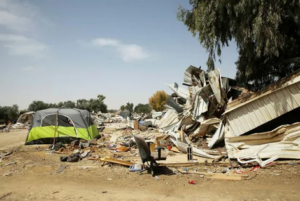Israel planning to relocate thousands of Bedouins to mobile home parks

The unrecognized Bedouin village of Bir al-Msas in southern Israel, November 2024
Or Kashti reports in Haaretz on 2 December 2024:
The Israeli government is developing a plan that will move thousands of Bedouins who today live in unregulated homes across the Negev Desert to temporary caravan parks located inside officially recognized communities.
The level of infrastructure planned for these”transitional neighborhoods” – including electricity, water and sewage – will be lower than required for structures in regulated communities. While the caravan parks are planned to last for five years, there is nothing in the plan that mandates local authorities to develop during that time the permanent infrastructure required.
The plan was designed by the Authority for Development and Settlement of the Bedouin in the Negev, which at the start of the year was put under the aegis of Diaspora Affairs Minister Amichai Chikli.
Under the plan, temporary housing will be established in all recognized Bedouin communities in the Negev – including Rahat, Kuseife, Hura, Shaqib al-Salam and the regional councils of Al-Kasom and Neveh Midbar. On Monday, the Southern District Planning and Building Committee will hear objections to the plan submitted by several Bedouin communities, both recognized and unrecognized, and civil society organizations.
Opponents of the plan say it is designed to enable “the rapid eviction of the Bedouin population” and to turn the Northern Negev into a “region of displaced people living in inadequate conditions.” On the other hand, the Bedouin local authorities assert that the plan aims “to ease the residential permit process” and promote regularization for residents of outlying areas.”
Some 300,000 Bedouin live in the Be’er Sheva subdistrict, more than half in unrecognized communities. Many of the communities in outlying areas are in negotiations over being regularized, so it is difficult to estimate the extent of the proposed relocation to temporary neighborhoods or which communities will participate.
Authority officials say developing permanent infrastructure in the temporary neighborhoods would “take a long time and require enormous capital.” Therefore, “reasonable infrastructure solutions” will be built as an “interim response,” as the plan puts it.
Several years ago, the Bedouin Authority proposed a plan that concluded that some 36,000 people needed to be moved for the sake of national infrastructure projects like the Route 6 extension, high-tension power lines and the like. Additionally, in the past year, the government has been advancing another plan that includes designating certain Bedouin areas for evacuation.
The newer plan does not provide details, but it appears that it will, among other things, relocate Bedouins for the purpose of establishing new Jewish settlements, expanding existing ones and “enabling the implementation of super-infrastructure in accordance with approved plans.” Building new neighborhoods would facilitate those plans.

Destruction of the unrecognized Bedouin village of Wadi Khalil.
The main criticism of the plan involves the infrastructure being planned for it. Water, for example, will be provided by pipes placed on the ground, making them vulnerable to inclement weather and other damage. The plan doesn’t require the neighborhoods to be linked to the nationwide electrical grid, instead relying on generators or solar power. Likewise, there will be no requirement to connect the neighborhoods to sewage systems; instead, they will have “a private sewage-disposal system” located next to homes.
In addition, the plan does not require the construction of proper roads, only a vague promise of “a reasonable access road to the property.” Bomb shelters will be made available “in accordance with Home Front Command guidelines,” without reference to the fact that residents will be living in the temporary structures that offer minimal protection.
“Experience teaches that arrangements based on temporary structures aren’t temporary – it becomes permanent, creating a problematic center for poverty, distress and crime,” said Ibrahim Abu Sahiban, Rahat’s municipal engineer, who opposes the plan.
He criticized the absence of permanent infrastructure and warned that plans “will create another impoverished neighborhood in a city that today already suffers from high crime rates.” He noted that other cities around the world, like Nairobi and Rio de Janeiro, are trying to “get rid of the shantytowns by moving them to permanent construction.”
Objections have been filed on behalf of 35 residents, the Council for Unrecognized Villages and various civil society organizations, including the Bimkom Association and Adalah.
“Instead of examining alternatives for recognition, planning and regulation of the existing villages, it was consciously decided to forgo solutions that would provide adequate living conditions,” said one of them. “It is based on the assumption that the country’s Bedouin citizens can be moved from place to place without permanent solutions or adequate living conditions, and by ignoring their heritage, social background and tradition.”
Opponents assert the plan creates two planning regimes in the Negev – one that works for the benefit of Jewish citizens and communities; and the other “sanctifies the value of evacuating Bedouin citizens for temporary residences.”
Cesar Yeudkin, Bimkom’s coordinator for Arab Localities, said that “over the years the state did nothing to undertake the required infrastructure work in recognized and regulated Negev communities. Now, it is demanding that Bedouin live in mobile structures connected to temporary infrastructure. There is no guarantee that after five years it will be possible to obtain a permit and enjoy proper infrastructure.”
The Bedouin Authority rejected the criticism, saying it would not create shantytowns, as Abu Sahiban asserted. “The structures that will be permitted in the licensing procedures must comply with all legal provisions,” the association said. “The proposed infrastructure complies with the latest mandatory standards,” and the plan was approved by all relevant professional bodies in the various government ministries.”
This article is reproduced in its entirety
